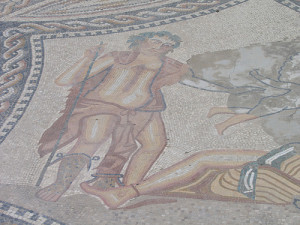Home » HART » HART Majors Rose Milnes and Lillian Boyle Awarded Fall 2017 Downing Grants
HART Majors Rose Milnes and Lillian Boyle Awarded Fall 2017 Downing Grants
Posted by vrcvanderbilt on Tuesday, November 28, 2017 in HART, News, Student/Alumni, VRC.
The Department of History of Art recently awarded Fall 2017 Downing grants to Rose Milnes and Lilliian Boyle. The department awards these Downing grants for travel to exhibitions and research centers to supplement academic instruction for HART majors who are in the Honors Program, in advanced seminars, or in upper-level “W” (writing) courses. These grants provide assistance for up to $2,000 in travel costs and are awarded in the fall and spring semesters of each academic year.
 Inspired by her Ancient Landscapes class with Prof. Betsey Robinson coupled with a personal connection to Morocco (her mother’s family descends from the Berbers who are native Moroccans), Milnes traveled to Morocco to study the mosaics of the ancient town of Volubilis, especially those with mythological themes. Many of them remain in situ on the floors of town houses she visited—the House of Orpheus, House of Ephebe, House of the Knight, House of Venus, House of the Labors of Hercules, and House of Dionysus—or were moved to the Rabat Archaeological Museum where she continued her viewing and research.
Inspired by her Ancient Landscapes class with Prof. Betsey Robinson coupled with a personal connection to Morocco (her mother’s family descends from the Berbers who are native Moroccans), Milnes traveled to Morocco to study the mosaics of the ancient town of Volubilis, especially those with mythological themes. Many of them remain in situ on the floors of town houses she visited—the House of Orpheus, House of Ephebe, House of the Knight, House of Venus, House of the Labors of Hercules, and House of Dionysus—or were moved to the Rabat Archaeological Museum where she continued her viewing and research.
Milnes will address how these mythological stories are depicted in North Africa in her research paper, Mythological Experiences in Roman North Africa: Mosaics in Volubilis. Do these stories have relevance to Volubilis itself? How do these stories reflect Roman societal culture and its values, especially in North Africa?
Milnes visited ancient historical sites and modern cities as well as several museums in her week-long stay in Morocco and plans to share her insights and photographs from her travels in a future blog post.
The home of Lillian Boyle’s great uncle in Rustic Canyon  in Southern California was designed by Ray Kappe. Thus her interest in the world-renowned architect whose work is regarded “as an extension of such Southern California architectural masters as Frank Lloyd Wright and Richard Neutra,” she wrote in her grant proposal.
in Southern California was designed by Ray Kappe. Thus her interest in the world-renowned architect whose work is regarded “as an extension of such Southern California architectural masters as Frank Lloyd Wright and Richard Neutra,” she wrote in her grant proposal.
Boyle traveled to Los Angeles to see the homes firsthand—at least three are in Rustic Canyon—and gather research from the Ray Kappe Archives housed in the Getty Research Institute. Kappe’s homes are known for their interaction with natural surroundings, “especially in Rustic Canyon, where his architecture represents the ultimate expression of the indoor-outdoor connectivity of his canon,” she wrote.
With her research paper (under Prof. Leonard Folgarait) focused on Kappe’s work in Rustic Canyon, Boyle will investigate the complicated relationship between humans and nature stemming from man-made architectural environments. Kappe’s architectural style “aims to reconcile this irresolvable tension through emphasizing the site and respecting the geography of the canyon; consequently, his homes in Rustic Canyon are applauded for fitting their environment.”
*Detail of Volubilis mosaic courtesy of Lietmotiv; photograph of Ray Kappe courtesy of Kappe Architects

©2026 Vanderbilt University ·
Site Development: University Web Communications